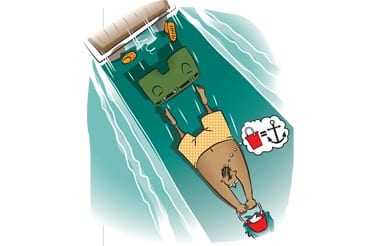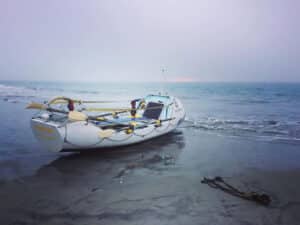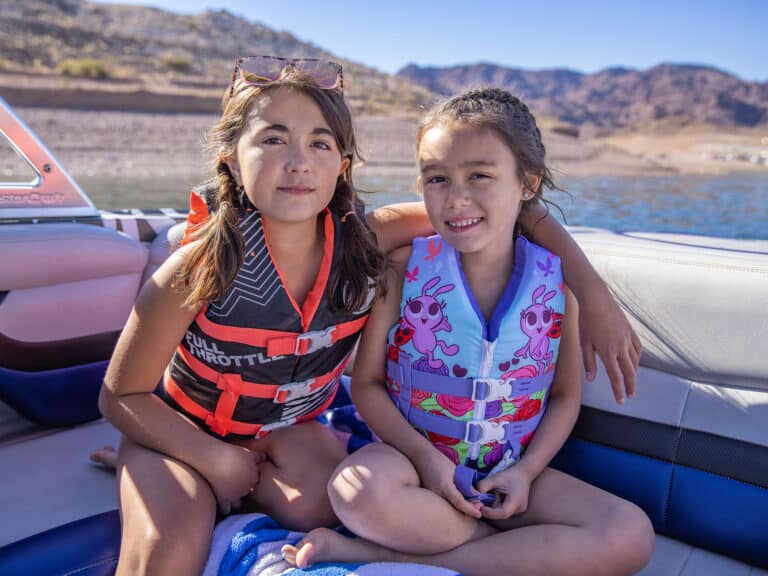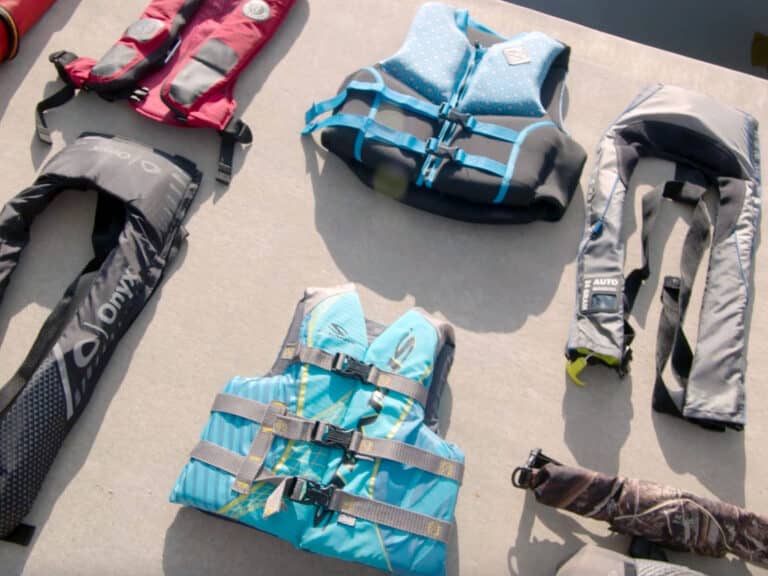
It was a sunny day on Delaware Bay, and our gang of five buddies from Philadelphia was headed out for some fishing aboard my new 25-foot Aquasport. The boat was well equipped with new electronics and all the required safety gear. I was a fairly new skipper but had received some training from a professional captain and considered myself competent.
We headed for Bug Light, where we’d heard the weakfish were biting. We were cruising along at a good clip over the calm water, and I asked one of the guys to get a bucket of water to thaw some bait. The next time I looked around, there were only three other people in the cockpit.
“Where’s Joe?” I yelled. The guys looked in confusion, and then we saw Joe, all 300 pounds of him, bobbing in the wake 100 yards behind us. Joe, by the way, can’t swim. I cut the throttles, turned the boat and raced back to get him. As we approached, we could see Joe was holding onto an overturned bucket for dear life. He’d tried to scoop water into the bucket while we were running, and the force of the moving water yanked him overboard. We threw him a life ring and pulled him alongside. Even though the water was calm and there was no wind, it took a good bit of doing to haul him aboard.
After the initial shock of the incident wore off we realized how lucky we’d been. On a calm, beautiful morning, not far from shore, we’d had a close brush with death and learned some lessons about the serious consequences of even momentary inattention.
The Confessor Replies:
Yep, there were definitely some lessons learned that day — the first being the importance of life jackets. Coast Guard statistics show drowning is the number-one cause of death among recreational boaters, and 86 percent of drowning victims in 2020 were not wearing a life jacket. The need for a life jacket should be obvious for crew members who can’t swim, but even accomplished swimmers don’t do well under the burden of sodden clothing and shoes, and rough weather will tire even the strongest in short order.
You had your Type IV throwable PFD within easy reach, so kudos for that. But as you discovered, hauling a person back aboard isn’t always a straightforward process. Had there been wind and waves to deal with, or had your crew member been injured, the situation would have been far more difficult and possibly dangerous.
In weather fair or foul, it’s a good idea to start each cruise with a safety briefing and perhaps a discussion on the proper handling of a man-overboard situation. There are plenty of good resources online detailing the particulars of a man-overboard emergency response.
Eyes on Target
If one of your crew falls in, immediately call out “man overboard” to alert the crew, and then check your heading and turn 180 degrees. Emphasize to your crew, “Don’t take your eyes off him.” Instruct them to point out the swimmer and continually call out the relative bearing from the bow and the distance, as in “11 o’clock, 75 yards.” At the same time, press the MOB button on the GPS/chart plotter to serve as a reference point in case you lose sight of the swimmer. If the man overboard is not wearing a life jacket, throw one out; if you lose visual contact, there’s a chance the swimmer might be able to find it.
If you can’t locate the swimmer, immediately alert the Coast Guard or local marine patrol via VHF radio Channel 16, and be prepared to report your exact position, a description of the crew member and the estimated time and position that he fell in. Next, hail all vessels in the area on Channel 16 and alert them to the man overboard situation, requesting their assistance in search and rescue.
In your own search, use the track or trail function on your chart plotter to retrace your course, keeping in mind that currents and wind might have carried the man overboard some distance from where he fell in. Instruct all hands to scan the water from the highest point possible, utilizing any binoculars on board, and their naked eyes.
Approach to the Swimmer
Don’t point the boat straight at the victim because your momentum might carry you over him, even after you cut the throttles. Circle around to the person, positioning the boat on the downwind side so that the wind does not push the boat on top of him. Have ready a throwable flotation device such as a life ring or throw cushion with about 50 feet of line attached
Once close enough, toss the ring or cushion. If in doubt, err on the side of overthrowing, so the swimmer can grab the line if not the flotation device. As soon as the man overboard is in tow, make sure the engine is out of gear, and then haul him in.
Boarding Process
Always carry a boarding device if your boat isn’t already equipped with a swim platform or other means of re-boarding from the water. It could be a rope ladder or hook-style boarding ladder that hangs over the gunwale.
You’ll likely need to help lift the swimmer aboard, even if you have a boarding device. Grab him under the arms as soon as you can. Once aboard, get the crew member as dry and warm as possible and ascertain his condition. Look for signs of hypothermia, ingested water or injuries. If you see signs for concern, seek medical attention immediately.
Edits by Jeff Moag/Water Sports Foundation
* * * * *
The U.S. Coast Guard is asking all boat owners and operators to help reduce fatalities, injuries, property damage, and associated healthcare costs related to recreational boating accidents by taking personal responsibility for their own safety and the safety of their passengers. Essential steps include: wearing a life jacket at all times and requiring passengers to do the same; never boating under the influence (BUI); successfully completing a boating safety course; and getting a Vessel Safety Check (VSC) annually from local U.S. Coast Guard Auxiliary, United States Power Squadrons(r), or your state boating agency’s Vessel Examiners. The U.S. Coast Guard reminds all boaters to “Boat Responsibly!” For more tips on boating safety, visit www.uscgboating.org.








